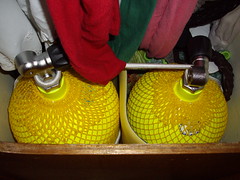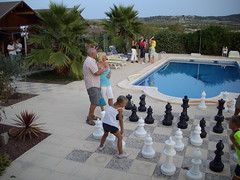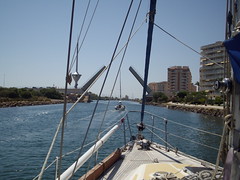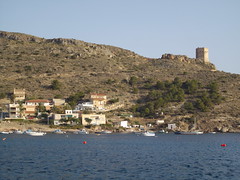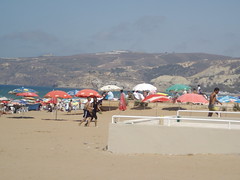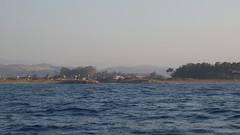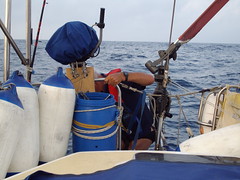 |
Roger cutting the fishing net
|
MONDAY - 30 JUNE - TUESDAY 1 JULY 2008
After Mohamed had taken our passports to Saidia to be stamped, and we’d completed formalities with customs, Mohamed waved us off and the Marineros released our lines. We have now got ten entry and exit stamps in our passports! We were sad to be leaving Morocco, where we have been for five weeks now, but are looking forward to the next stage and getting to the Balearics.
The autohelm was not very stable and the hydrovane did not always hold the course when there wasn’t enough wind. About 30 miles from Morocco and 70 from Spain a light aircraft flew buzzed us, did a circle and flew back to Morocco.
The wind got up to a Force 4 – 5 and we managed to sail for a couple of hours but the course was taking us to Mottril, about 90 miles west of where we wanted to go, so we had to motor-sail. I went for a sleep about 8.30 p.m. as I was doing the 10 – 2 watch, and heard Roger yelling for help. We had hooked up a fishing net which was about 3 miles long with very few buoys on it and no flags on the buoys. We were about 33 miles from the Moroccan coast and 67 from Spain. We could see the fishing boat still laying out the net. We tried radioing him several times but there was no response and the sea was too bouncy to go in and have a look. In the end, there was no alternative but to cut the net, which luckily was not wound around the prop as Roger had just cut the engine in order to sail.
We had to put the clocks forward again now we were back in Spain. I’ve lost count how many times we’ve changed our clocks over the last five weeks!
I was on watch from 10 p.m. and the wind got up so I sailed for a while, but holding a course was difficult. I was feeling a little seasick from when we were trying to sort the net out and the boat was wallowing in the sea. The wind changed direction and was coming from behind the boat, which meant the boat was liable to jibe and was rolling. This always has a bad effect on me and I was very sick. I carried on for a while but needed to put the engine on to get the headsail in to make the boat more comfortable and steer our course, so I called Roger up about 12.30 a.m. As we were sorting out the sails we both saw a shooting star, and when Roger was on watch he said he saw the most spectacular comet he’s ever seen.
We hear some appalling radio use in Spain but tonight seemed to be particularly bad. There was very loud music being played down the microphone, whistling, people putting on silly voices and some swearing. Some of it just for the sake of swearing down the microphone, but there was one conversation between two merchant vessels discussing whether to pass port to port which one misunderstood and the language of the other one is not repeatable!
Roger woke me up about 8.00 a.m. to come and see the dolphins who were welcoming us to Spain. These were larger than the dolphins we had seen before. We passed the beautiful Cabo de Gato and went to Puerto de San Jose, a small marina. We asked how much for the night and were told 50 euros, so we said, ‘No gracias, adios!” The wind was coming from the East, which doesn’t give much protection along the Spanish coast, but it wasn’t very strong so we decided to try an anchorage.
We headed for Cala de San Pedro, about 8 miles further on, a beautiful bay with high hills behind it. The only way to get there is by boat or a long cliff hugging walk. The wind got up to about a Force 4 making the sea a little too rough to swim ashore, although the boat was quite comfortable. On the beach a little nudist community had grown up with a small café and people camping or living in ruined buildings. Boats came and went from the Las Negras, the village around the corner, including a water taxi. The water was lovely and warm and very clear so I swam round the boat to check the anchor was dug in while Roger had a siesta.
